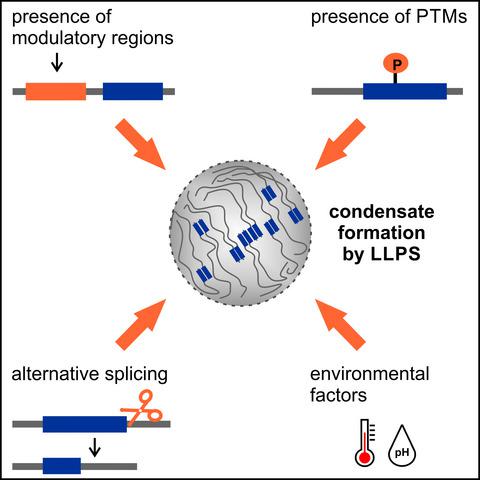Our official English website, www.x-mol.net, welcomes your feedback! (Note: you will need to create a separate account there.)
A guide to regulation of the formation of biomolecular condensates.
The FEBS Journal ( IF 5.4 ) Pub Date : 2020-03-14 , DOI: 10.1111/febs.15254 Anna Bratek-Skicki 1 , Rita Pancsa 2 , Balint Meszaros 3 , Joris Van Lindt 1 , Peter Tompa 1, 2, 4
The FEBS Journal ( IF 5.4 ) Pub Date : 2020-03-14 , DOI: 10.1111/febs.15254 Anna Bratek-Skicki 1 , Rita Pancsa 2 , Balint Meszaros 3 , Joris Van Lindt 1 , Peter Tompa 1, 2, 4
Affiliation

|
Cellular organelles that lack a surrounding lipid bilayer, such as the nucleolus and stress granule, represent a newly recognized, general paradigm of cellular organization. The formation of such biomolecular condensates that include 'membraneless organelles' (MLOs) by liquid-liquid phase separation (LLPS) has been in the focus of a surge of recent studies. Through a combination of in vitro and in vivo approaches, thousands of potential phase-separating proteins have been identified, and it was found that different cellular MLOs share many common components. These perplexing observations raise the question of how cells regulate the timing and specificity of LLPS, and ensure that different MLOs form and disperse at the right moment and cellular location and can preserve their identity and physical separation. This guide gives an overview of basic regulatory mechanisms, which manifest through the action of intrinsic regulatory elements, alternative splicing, post-translational modifications, and a broad range of phase-separating partners. We also elaborate on the cellular integration of these different mechanisms and highlight how complex regulation can orchestrate the parallel functioning of a dozen or so different MLOs in the cell.
中文翻译:

指导生物分子缩合物形成的指南。
缺乏周围脂质双分子层的细胞器,例如核仁和应激颗粒,代表了一种新近公认的细胞组织的一般范例。通过液-液相分离(LLPS)形成包括“无膜细胞器”(MLO)的生物分子缩合物已成为近期研究的重点。通过体外和体内方法的结合,已经鉴定出数千种潜在的相分离蛋白,并且发现不同的细胞MLO共享许多共同的成分。这些令人困惑的观察提出了一个问题,即细胞如何调节LLPS的时间和特异性,并确保不同的MLO在正确的时机和细胞位置形成并分散,并可以保持它们的身份和物理分离。本指南概述了基本的调控机制,这些机制通过内在的调控元件,替代剪接,翻译后修饰和广泛的相分离伙伴的作用来体现。我们还详细介绍了这些不同机制的细胞整合,并强调了复杂的调节如何协调细胞中十几个左右不同MLO的并行功能。
更新日期:2020-02-20
中文翻译:

指导生物分子缩合物形成的指南。
缺乏周围脂质双分子层的细胞器,例如核仁和应激颗粒,代表了一种新近公认的细胞组织的一般范例。通过液-液相分离(LLPS)形成包括“无膜细胞器”(MLO)的生物分子缩合物已成为近期研究的重点。通过体外和体内方法的结合,已经鉴定出数千种潜在的相分离蛋白,并且发现不同的细胞MLO共享许多共同的成分。这些令人困惑的观察提出了一个问题,即细胞如何调节LLPS的时间和特异性,并确保不同的MLO在正确的时机和细胞位置形成并分散,并可以保持它们的身份和物理分离。本指南概述了基本的调控机制,这些机制通过内在的调控元件,替代剪接,翻译后修饰和广泛的相分离伙伴的作用来体现。我们还详细介绍了这些不同机制的细胞整合,并强调了复杂的调节如何协调细胞中十几个左右不同MLO的并行功能。


























 京公网安备 11010802027423号
京公网安备 11010802027423号